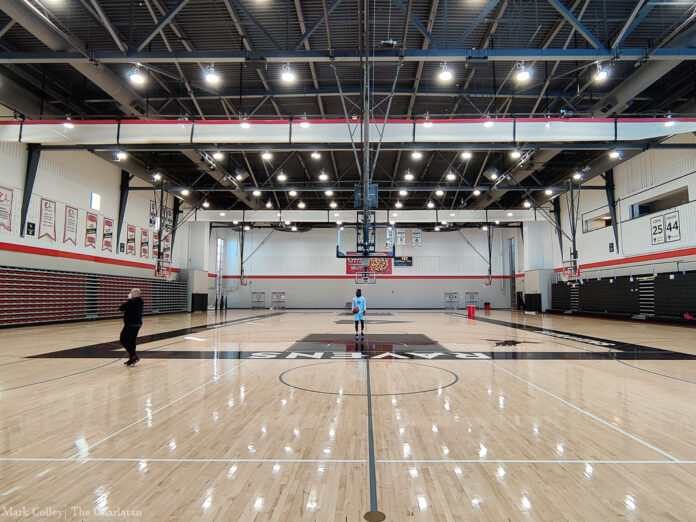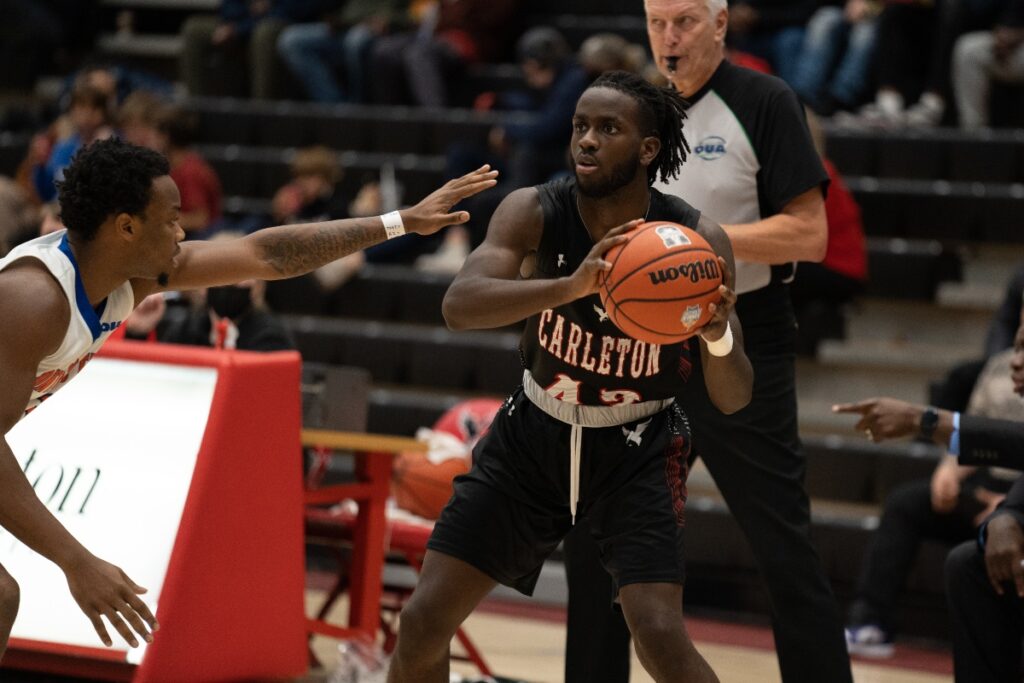
Early in the afternoon on Jan. 31, the Ravens’ Nest at Carleton University is cavernous. The bleachers are folded neatly against the walls and the sun streams through a two-story window.
The only sound is the repetitive hollow thud of basketballs hitting plywood. The shrill squeak of sneakers echoes around the gym.
The Carleton Ravens men’s basketball team’s original practice plan for 1:30 p.m. was axed when a player had a fever. Instead, only guards Nelson Cilien and Wazir Latiff shot baskets on an empty court.
Training had finally begun for the Ravens, 46 days after Ontario University Athletics (OUA) announced the suspension of games and 29 days after the provincial government put in place new restrictions due to the spread of the Omicron variant. Despite the quiet, improvised practice, one thing was clear: The OUA was back.
The conference’s return brings about a daunting set of challenges, from building up cardio and relearning team systems to scheduling nightmares and potential COVID-19 infections. The emotion of being back on the court and ice is one thing—actually continuing the season successfully is another.
“It’s just unprecedented having this amount of time off in the middle of the season,” said men’s basketball head coach Taffe Charles, whose team will have gone 77 days between games when it returns on Feb. 11. “[I’m] just trying to figure out how to coach again.”

During the break, teams stayed active with Zoom workout sessions. The men’s and women’s basketball teams worked through film of practices and games with Dave Smart, Carleton’s director of basketball operations, while women’s hockey players did daily body weight workouts at home.
Some players who went home to other provinces had access to gyms. Most of those who stayed in Ontario didn’t.
Instead, Carleton’s High Performance Centre put together a plan for players to follow as best they could. Players ran outside and worked out in basements and garages.
Now, as players return to training on campus, shaking off the rust is paramount.
“At this high a level … if you take three days off, it takes you a couple days to get back into the rhythm again,” Carleton men’s hockey forward Rykr Cole said. “It’s really affected not only everyone’s physical capabilities but the vibe around the rink.”
The break was especially detrimental to the men’s hockey team, which saw five players sign professional contracts in the United States and Europe. Veteran players will have to fill a leadership hole and younger players will see more playing time.
“Replacing those guys isn’t easy. They’re not really replaceable at all,” Cole said.
For women’s hockey defender Angelina Callocchia, who is graduating this year, the shutdown brought about its own set of emotions: the fear she had played her last game as a Raven.
“When you’re in your final year, it’s kind of like, okay, there’s 20 games ahead of me. You kind of have the countdown going,” Callocchia said. “You don’t expect that halfway through the season, it might be your last game.”
While the women’s hockey team also held their first practice on Jan. 31, the Réseau du sport étudiant du Québec (RSEQ) has yet to announce when games will resume. The frustration of seeing the rest of Carleton’s varsity teams, who play in the OUA, ramp up while women’s hockey is left in a holding pattern is evident.
“We’re all at the same school. We’re all in the same circumstances,” Callochia said, acknowledging the challenges of interprovincial travel. “It’s frustrating to see that they get the opportunity to continue their season sooner than we do.”

The shutdown wasn’t all bad. It gave teams the opportunity to reset after a mad dash through the first four weeks of the season. Instead of fighting fires and preparing for games, coaches could refocus on the fundamentals and what they want to accomplish.
For players, it offered the chance to mentally and physically reset.
Cole and Callocchia spent more time with family around the holidays. Océane Kounkou, a guard on the women’s basketball team, dedicated time to experiencing the outdoor winter activities she normally misses during the season.
This included skating two to three times a week on the Rideau Canal. Her and her teammates, as well as players on the men’s basketball team, occasionally raced down the Rideau.
The return of university sports is tentative. While both the OUA and U Sports announced a revised championship schedule, with championships pushed back by two to three weeks, postponements and cancellations are still possible.
RSEQ has yet to announce its plans for games resuming. Atlantic University Sport (AUS) announced all sports will return in all provinces on Feb. 18, after originally announcing the return of men’s hockey, women’s hockey and women’s volleyball in only New Brunswick.
Even for Canada West, which never shut down, 42 games have been postponed since Jan. 6, 36 of which were due to COVID-19 related protocols and travel restrictions.
COVID-19 cancellations are a real threat in the OUA, too.
“There’s a situation where even myself could be gone from games,” Charles said. “Assistant coaches gotta be ready to coach, players who don’t play that much gotta be ready to play more. We just gotta kind of adjust the best we possibly can.”
Overcoming the rust of a month spent idle is difficult enough. Will teams be able to dance their way through a fifth wave?
“It depends,” Charles said. “Can you get lucky?”
Featured image by Mark Colley.





